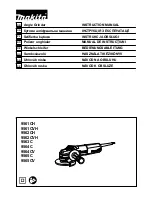
50
E-flite Habu 32 EDF ARF Assembly Manual
Center of Gravity
Required parts
Assembled airframe
Required Tools and Adhesives
Balancing stand
Felt-tipped pen
CAUTION
:
Do not inadvertently skip this step or
property damage and injury could occur.
When balancing your model, adjust the motor battery
as necessary so the model is level or slightly nose
down. This is the correct balance point for your model.
You should find the CG to be very close with the
battery installed as shown in this manual. Mark the
location of the battery on the battery tray using a felt-
tipped pen so it can be returned to this position if it is
removed from your model.
After the first flights, the CG position can be adjusted
for your personal preference.
1. Attach the wings to the fuselage following the
procedure outlined earlier in this manual. Attach
the fan cover to the fuselage using the four 2mm x
8mm self-tapping screws removed earlier and a #1
Phillips screwdriver.
2. The recommended Center of Gravity (CG)
location for your model is 3
15
/
16
to 4
1
/
2
inches
(100 to 115mm) back from the leading edge of
the wing as shown with the battery pack installed.
Mark the location of the CG on the top of the wing
with a felt-tipped pen.
3. When balancing your model, support the plane
inverted at the marks made on the top of the wing
with your fingers or a commercially available
balancing stand. This is the correct balance
point for your model. Make sure your model is
assembled and ready for flight before balancing.
Balancing Stand
If you have installed retracts, balance
your model with the gear down.
Control Throws
1. Turn on the transmitter and receiver of your
model. Check the movement of the rudder using
the transmitter. When the stick is moved right,
the rudder should also move right. Reverse the
direction of the servo at the transmitter if necessary.
2. Check the movement of the elevator with the
radio system. Moving the elevator stick toward
the bottom of the transmitter makes the airplane
elevator move up.
3. Check the movement of the ailerons with the
radio system. Moving the aileron stick right makes
the right aileron move up and the left aileron
move down.
4. Use a ruler to adjust the throw of the elevator,
ailerons and rudder. Adjust the position of
the pushrod at the control horn to achieve the
following measurements when moving the sticks to
their endpoints.
Note: Use caution with high rates on the
elevator and ailerons. High rates are only
used for snap and spin aerobatic maneuvers.
Middle rates are suggested for takeoff
and landings. Low rates are suggested for
standard flight maneuvers. If your radio only
has the option for two rates, use the middle
and low rates.
Aileron
High Rate
Up:
11mm
25% Expo
Down: 11mm
25% Expo
Mid Rate
Up:
8mm
15% Expo
Down: 8mm
15% Expo
Low Rate
Up:
7mm
10% Expo
Down: 7mm
10% Expo







































